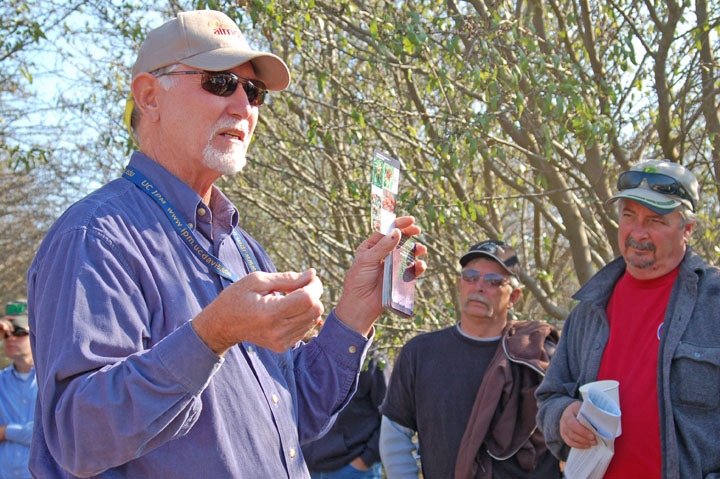
Continuing funding cuts at the state and federal level are threatening the research capacity for almonds and other California crops. Within the next decade, fully half of the current ANR members will retire.Reduced federal spending for USDA Agricultural Research Service last year eliminated funds for some 120 ARS scientists and staff overnight; 10 research stations and programs closed in 2011.
November 1, 2012

Virtually all California crops have benefited from public funding for agricultural research. This funding not only supports staff and facilities for basic laboratory and field research, but also supports applied research and Extension that moves basic research into commercial settings and helps communicate findings and recommendations developed through that research to the grower community.
Research through university campuses, UC Cooperative Extension, and USDA Agricultural Research Service not only improves productivity and makes California growers more competitive in the international market, it also helps producers use resources more efficiently and minimize environmental and other societal impacts.
Competitive Farm Bill Specialty Crop Block Grants and other sources have provided increased financial resources in recent years to initiate and leverage ongoing research. For almonds, these funds have not only leveraged our ongoing research but have also enabled us to pursue more comprehensive and interdisciplinary work in such areas as fertility and irrigation management, honey bee health, and rootstock development.
Although welcome, these new sources of competitive funding do not go far enough. They do not address the need for permanent funding to sustain the faculty and staff who generate the new technology. A new phrase has come into use to describe this condition —research capacity.
Loss of Farm Advisors and Researchers
Continuing funding cuts at the state and federal level are threatening the research capacity for almonds and other California crops. A recent review of the outlook for research capacity in almonds reveals a startling reality. Within the next decade, it is expected the almond industry will lose half of its current farm advisors and half its agricultural experiment station research staff —and this 10-year trend has already started.
To date, 44 percent of the state’s almond acreage is not covered by a farm advisor, with current vacancies in Fresno, Madera, Kern and Glenn Counties. These farm advisors regularly conduct problem-solving research under regional growing conditions, often adapting and applying basic research findings, and also regularly communicate with growers and their PCAs, and farm managers through field days and farm calls. The lack of farm advisors in this important San Joaquin Valley region also puts significant strain on current farm advisors in other counties.
Attrition grows
This unfortunate trend goes beyond farm advisors. For instance, two of the industry’s entomologists and one extension nematologist have recently retired, and an Extension plant pathologist position has been vacant for a number of years. All this leaves major gaps in the maintenance and further development of integrated pest management in almonds.
Over the last 20 years, continuing cuts in public funding for agricultural research are having a significant impact on the pool of skilled researchers available to carry out research projects funded through soft money grants. At UC Agricultural and Natural Resources (ANR) division, there has been a 40 percent decline in the number of “boots on the ground” Extension specialists and farm advisors from a peak of 300 farm advisors and 200 specialists in 1990 to 200 advisors and 100 specialists today. Within the next decade, fully half of the current ANR members will retire.
Faculty Retirement
During that same period, the number of faculty research positions at UC and CSU campuses has also declined. At UC Davis, College of Agriculture and Environmental Sciences faculty positions have declined 25 percent since 1990, and another 50 percent of faculty is expected to retire within the next decade. Colleges at other UC campuses at Berkeley and Riverside have also taken significant cuts.
Reduced federal spending for USDA Agricultural Research Service (ARS) last year eliminated funds for some 120 ARS scientists and staff overnight; 10 research stations and programs closed in 2011. More than 200 USDA staff and researchers accepted early retirement offers in 2011, and for every three positions that retire only one new position is expected to be refilled.
For more, see: USDA shutdown of 259 offices stirs call for congressional action
This is a startling level of attrition along the research continuum, but especially on the applied research and Extension side. All of these cuts are creating a drain on the research talent and facilities needed to carry out even basic research, much less move that research out of the laboratory and greenhouse and into the field.
The impact of these cuts in public investment is already being felt. Economists have documented a disturbing link between reduced public spending on agricultural research and Extension and a slowdown in U.S. agricultural productivity growth. In traveling the world, it is clear to see that this unique system of public and private research has contributed significantly to making California growers sustainable and competitive in the global market.
As these permanent budget cuts continue, private industry must be involved in securing research capacity at the basic and applied level to ensure California growers maintain their competitive edge.
The Almond Board is currently engaged in prioritizing research needs for the industry into the future and exploring ways to support research capacity through public and private partnerships.
You May Also Like



